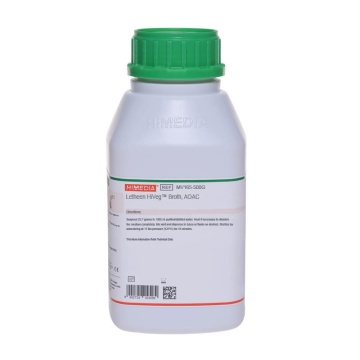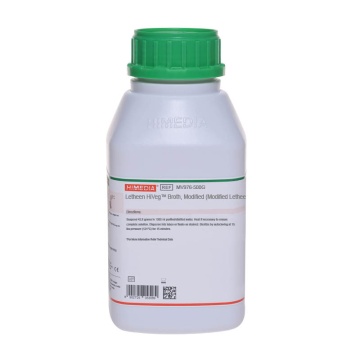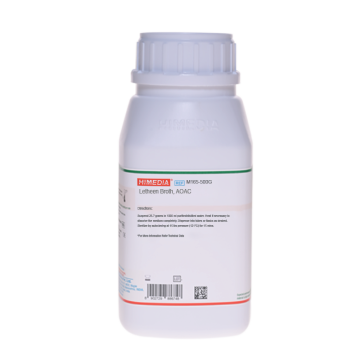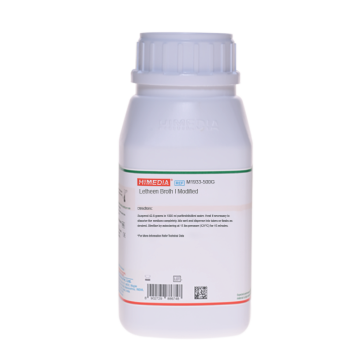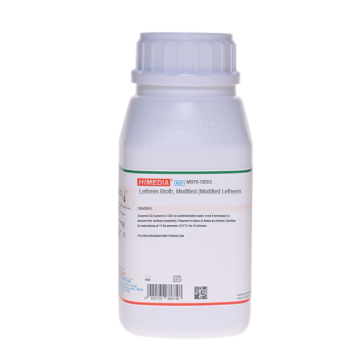 Your enquiry has been submitted
Your enquiry has been submitted
Letheen Broth w/ Triton X-100
Sterility Testing#CC293D
Intended Use:
Recommended for screening cosmetic products for microbial contamination.
Composition**
| Ingredients | Gms / Litre |
|---|---|
| Peptone | 10.000 |
| HM peptone B # | 5.000 |
| Sodium chloride | 5.000 |
| Lecithin | 0.700 |
| Polysorbate 80 (Tween 80) | 5.000 |
| Triton X-100 | 1.000 |
Final pH (at 25°C): 7.0±0.2
**Formula adjusted, standardized to suit performance parameters # Equivalent to Beef extract
Directions
Suspend 26.7 grams in 1000 ml purified / distilled water. Heat if necessary to dissolve the medium completely. Dispense into tubes or flasks as desired. Sterilize by autoclaving at 15 lbs pressure (121°C) for 15 minutes.
Principle And Interpretation
In the early 40s, Weber and Black recommended the use of lecithin and polysorbates to neutralize the antimicrobial action of the quaternary ammonium compounds (6). In 1965, the methodology was accepted by AOAC for the antimicrobial assays and extended their use to all the cationic detergents. In 1978, the FDA incorporated it as pre-enrichment medium for every microbial examination of cosmetics.
There are great chances of altering the chemical composition of cosmetics by the metabolism of organisms thereby spoiling and causing harm to the users (1,5,7). Direct colony counts and enrichment culturing are the methods of choice for isolating microorganisms from cosmetic products. The word Letheen represents a combination of lecithin and polysorbate (tween) 80. Letheen Broth with Triton X-100 is recommended for luxuriant growth of most organisms for detection of yeast and moulds. Triton X-100 is non-ionic and disperses microorganisms making counting easier.
Peptone, HM peptone B provide nitrogenous nutrients, carbon compounds and trace elements to the microorganisms. Incorporation of lecithin and polysorbate 80 to the medium enables the recovery of bacteria from materials containing residues of disinfectant compounds or preservatives used in cosmetics. Polysorbate 80 is added to nullify phenolic compounds, hexachlorophene, formalin and along with lecithin neutralizes ethyl alcohol (2). Lecithin also neutralizes quaternary ammonium compounds present in the cosmetics. Sodium chloride maintains the osmotic balance of the medium. Triton X-100 acts as a surfactant. Cosmetics contain preservatives and they should be at least partially inactivated during the plating and this medium helps in dilution as well as neutralizing.
Type of specimen
Cosmetic products
Specimen Collection and Handling
For cosmetic samples follow appropriate techniques for handling specimens as per established guidelines (3,4). After use, contaminated materials must be sterilized by autoclaving before discarding.
Warning and Precautions
Read the label before opening the container. Wear protective gloves/protective clothing/eye protection/face protection. Follow good microbiological lab practices while handling specimens and culture. Standard precautions as per established guidelines should be followed while handling specimens. Safety guidelines may be referred in individual safety data sheets.
Limitations
- Further biochemical and serological tests must be carried out for complete identification.
Performance and Evaluation
Performance of the medium is expected when used as per the direction on the label within the expiry period when stored at recommended temperature.
Quality Control
Appearance: Cream to yellow homogeneous free flowing powder
Colour and Clarity of prepared medium: Yellow coloured, clear solution in tubes
Reaction: Reaction of 2.67% w/v aqueous solution at 25°C. pH: 7.0±0.2
pH: 6.80-7.20
Cultural Response
Cultural characteristics observed after an incubation at 35-37°C for 18-48 hours.
| Organism | Inoculum (CFU) | Growth |
|---|---|---|
| Escherichia coli ATCC 25922 (00013*) | 50-100 | luxuriant |
| Staphylococcus aureus subsp. aureus ATCC 6538 (00032*) | 50-100 | luxuriant |
| Staphylococcus aureus subsp. aureus ATCC 25923 (00034*) | 50-100 | good-luxuriant |
Key: (*) Corresponding WDCM numbers.
Storage and Shelf Life
Store between 10-30°C in a tightly closed container and the prepared medium at 15-25°C. Use before expiry date on the label. On opening, product should be properly stored dry, after tightly capping the bottle in order to prevent lump formation due to the hygroscopic nature of the product. Improper storage of the product may lead to lump formation. Store in dry ventilated area protected from extremes of temperature and sources of ignition. Seal the container tightly after use. Product performance is best if used within stated expiry period.
Disposal
User must ensure safe disposal by autoclaving and/or incineration of used or unusable preparations of this product. Follow established laboratory procedures in disposing of infectious materials and material that comes into contact with sample must be decontaminated and disposed of in accordance with current laboratory techniques (3,4).
Reference
- Dunningan A. P., 1968, Drug Cosmet. Ind., 102:43.
- Favero (Chm.), 1967, A State of the Art Report, Biological Contamination Control Committee, American Association for Contamination Control.
- Isenberg, H.D. Clinical Microbiology Procedures Handbook 2nd Edition.
- Jorgensen, J.H., Pfaller, M.A., Carroll, K.C., Funke, G., Landry, M.L., Richter, S.S and Warnock., D.W. (2015) Manual of Clinical Microbiology, 11th Edition. Vol. 1.
- Smart R. and Spooner D. F., 1972, J. Soc. Cosmet. Chem., 23:721.
- Weber and Black, 1948, Soap Sanitary Chem., 24:134-139
- Wilson L. A. and Ahearn D. G., 1977, Am. J. Opthalmol., 84:112.
| Product Name | Letheen Broth w/ Triton X-100 |
|---|---|
| SKU | M1459 |
| Product Type | Regular |
| Physical Form | Powder |
| Origin | Animal |
| Packaging type | HDPE |
| References | 1. Dunningan A. P., 1968, Drug Cosmet. Ind., 102:43. |
| Customized Product Available | No |




